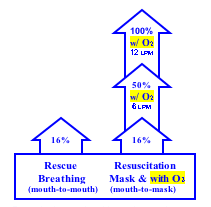- PRODUCTS
- Advanced Life Support (ALS) Equipment & Accessories
- Automated External Defibrillators (AEDs), Accessories & Packages
- CPR Technology & Emergency Oxygen Equipment
- Disaster Preparedness & Survival
- Emergency Instruction Device (EID)
- Evacuation Equipment
- First Aid Kits & Refills
- Miscellaneous Components & Refills
- Personal Protective Equipment, BBP & Sharps
- Responder, Trauma, Active Violence & Severe Bleed Kits
- Self-contained Emergency Treatment (SET) System
- Services
- Software & Mobile Apps
- Training
- SERVICES
- SOFTWARE
- TRAINING
- DISTRIBUTORS
- RESOURCES
- CONTACT
- PRODUCTS
- Advanced Life Support (ALS) Equipment & Accessories
- Automated External Defibrillators (AEDs), Accessories & Packages
- CPR Technology & Emergency Oxygen Equipment
- Disaster Preparedness & Survival
- Emergency Instruction Device (EID)
- Evacuation Equipment
- First Aid Kits & Refills
- Miscellaneous Components & Refills
- Personal Protective Equipment, BBP & Sharps
- Responder, Trauma, Active Violence & Severe Bleed Kits
- Self-contained Emergency Treatment (SET) System
- Services
- Software & Mobile Apps
- Training
- SERVICES
- SOFTWARE
- TRAINING
- DISTRIBUTORS
- RESOURCES
- CONTACT
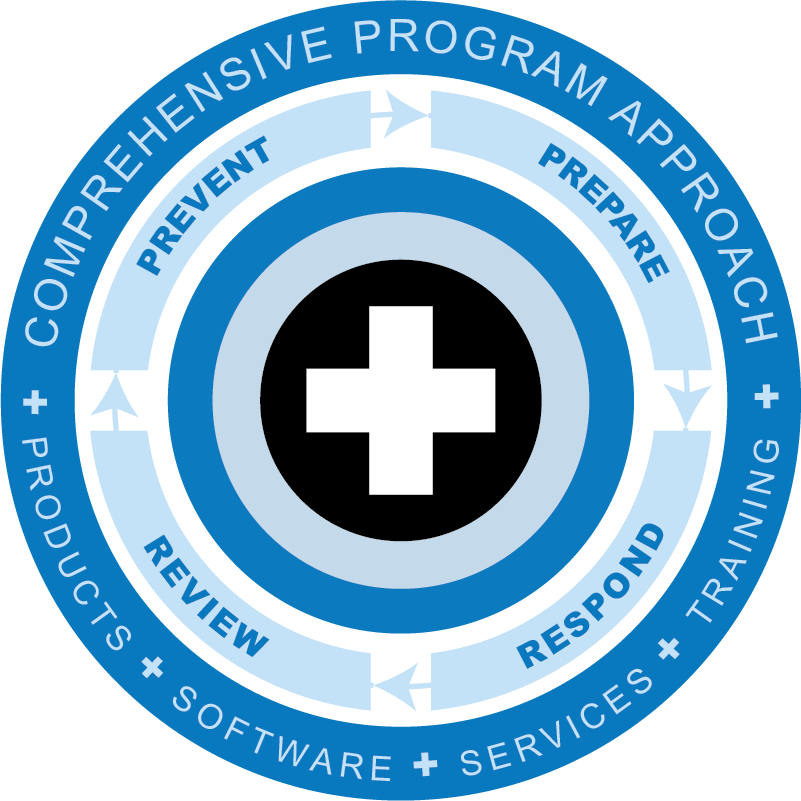
CPR Technology & Emergency Oxygen Equipment
Heart disease and cardiac emergencies are leading killers in the US. CPR Technology such as Automated Chest Compression Assistance devices and CPR feedback tools can be used by licensed professionals in EMS. These tools are critical lifesaving assets proven to improve survival rates for out of hospital patient events. Think Safe has the technical experts with the knowledge you need to start, update, innovate, and improve your EMS responder CPR program with innovative equipment while controlling costs and mitigating risk.
Think Safe's Offering of CPR Technology Dramatically Improves Survival Outcome Rates
Physio Control LUCAS ®
Keeping the Flow Up
In order to be able to save the lives of sudden cardiac arrest patients and avoid neurological damage, a steady supply of oxygen to the heart and brain is necessary. Life-sustaining circulation can be created through effective and uninterrupted chest compressions. Performing manual chest compressions of high quality is both difficult and tiring, and impossible in certain situations. The quality varies depending on who provides CPR and deteriorates quickly after only 1 or 2 minutes.
Meet LUCAS® 3, Version 3.1, Automated Chest Compression System
The latest LUCAS® 3.1 version allows professional users to tailor setup options for compression rate/depth, pauses, alerts, timer, and ventilation features to meet local emergency care protocols. LUCAS® 3.1 now includes Wi-Fi® connectivity with a LIFENET® System account to enable users to set up device readiness notifications, modify setup options and transmit device reports wirelessly to users over e-mail when not in clinical use. Users can set automatic e-mail reports to facilitate post-event reviews and device management reports on battery expiration dates, last service date, and device maintenance.
LUCAS® - Standardizing the Quality of Chest Compressions
The LUCAS™ Chest Compression System is a safe and efficient tool that standardizes chest compressions in accordance with the latest scientific guidelines. It provides the same quality for all patients and over time, independent of transport conditions, rescuer fatigue, or variability in the experience level of the caregiver. By doing this, it frees up rescuers to focus on other lifesaving tasks and creates new rescue opportunities.
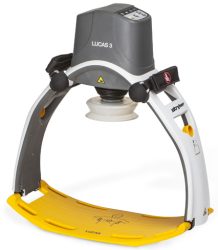
Safe and Effective
Experimental studies show that the mechanically controlled LUCAS™ compressions are able to sustain a higher blood flow to the brain and heart compared to manual compressions. The side-effects are similar as for manual compressions. LUCAS® does compressions according to guidelines – on the middle of the chest, not more, not less.
Quick and Easy
The LUCAS® device is easy to carry and handle, and can be applied to the patient with interruptions of manual compressions of less than 20 seconds.
Physio Control TrueCPR™ Coaching Device
The TrueCPR™ Coaching Device is designed to optimize the quality and performance of manual CPR by providing feedback to rescuers in both real-time and after the event. The TrueCPR™ device measures compression depth on compliant surfaces and in moving vehicles using a unique technology called Triaxial Field Induction.
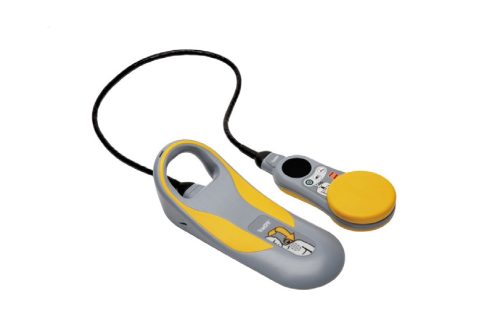
Triaxial Field Induction
Triaxial Field Induction (TFI) is a unique technology that allows the TrueCPR™ Coaching Device to accurately measure compression depth on compliant surfaces or in moving vehicles. Magnetic fields emit from the backplate in three directions. As the chest pad moves through the field, it is able to calculate its distance from the backplate at any point in time, giving rescuers a true anterior/posterior chest compression depth measurement.
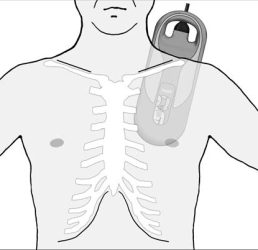
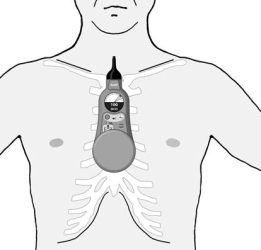
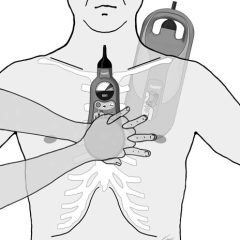
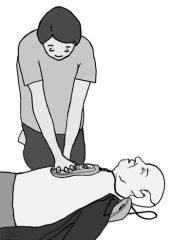
Emergency Oxygen
LIFE® first-aid Emergency Oxygen Unit Cylinders are shipped full of oxygen, ready-to-use and are easily disposable/replaceable or refillable. Check out these options for Emergency Oxygen in Portable and/or Wall-Mounted units for first responders.
LIFE® OxygenPac
LIFE® OxygenPac is the superior portable Emergency Oxygen
wall-mounted unit which is an easy-to-use oxygen Inhalator for a
breathing victim and a Resuscitator adjunct for a non-breathing victim.


LIFE® SoftPac™
LIFE® SoftPac™ is the lightweight, 6 pound Emergency Oxygen unit,
preferred for frequent carrying, and as an AED companion Oxygen unit.
Part 4: Basic Life Support (BLS) recognition of signs of sudden cardiac arrest (SCA), heart attack, stroke, and foreign-body airway obstruction (FBAO); cardiopulmonary resuscitation (CPR); and defibrillation with an automated external defibrillator (AED) for lay rescuers and healthcare providers.
During CPR the purpose of ventilation is to maintain adequate oxygenation …. therefore, both ventilations and compressions are important for victims of prolonged ventricular fibrillation SCA, when oxygen in the blood is utilized. Ventilations and compressions are also important for victims of asphyxial arrest, such as children and drowning victims who are hypoxemic at the time of cardiac arrest. Mouth-to-Mask Rescue Breathing and Bag-Mask Ventilation — Masks should include an oxygen inlet.
►… use supplemental oxygen at a flow rate of 10 to 12 LPM… to enable delivery of 100% oxygen (initially) (EDIT )…and the FDA regulation minimum capability of 6 LPM remains in effect. LIFE® 612™ models deliver both the FDA minimum of 6 LPM and the AHA recommended 100% inspired oxygen at 12 LPM, in just two simple settings which read “NORM” & “HIGH”. Only LIFE Corporation offers the 6 & 12 LPM (“NORM & HIGH”) simple 2 flow-rate choices.
Part 7.1: Adjuncts for Airway Control and Ventilation — recommendations for the support of ventilation and oxygenation during resuscitation and the periarrest period. The purpose of ventilation during CPR is to maintain adequate oxygenation and elimination of carbon dioxide. To improve sufficient oxygenation,
►… give 100% inspired oxygen during Basic Life Support (BLS)… and Advanced Cardiac Life Support (ACLS) … as soon as it becomes available. High inspired oxygen tension will tend to maximize arterial oxygen saturation and, in turn, arterial
oxygen content. This will help support oxygen delivery when cardiac output is limited.
●… short term oxygen therapy does not produce oxygen toxicity (… and should not be withheld for fear of suppressing respiration. — ref.2000AHA) Bag-Mask Ventilation requires adequate training and frequent practice, can produce gastric inflation with complications, including regurgitation, aspiration, pneumonia …and can decrease respiration. Advanced Airway endotracheal tube interventions are complicated, failure can occur …and there is no evidence that advanced airway measures improve survival rates in pre-hospital cardiac arrest.
Part 7.5: Post-Resuscitation Support — the provider should support adequate airway and breathing and… administer supplemental oxygen …
Part 9: Adult Stroke… several studies showing improved functional outcomes and survival in which higher supplementary oxygen concentrations were used… administer supplemental oxygen to hypoxemic stroke patients and those with unknown oxygen saturation.
Part 10.5: Near-Fatal Asthma — Primary Therapy – Oxygen… Provide oxygen to all patients with severe asthma, even those with normal oxygenation.
Part 10.6: Anaphylaxis – Intervention to Prevent Cardiopulmonary Arrest… administer oxygen at high flow rates.

GUIDELINES 2000 for Cardiopulmonary Resuscitation and Emergency Cardiovascular Care 2000 American Heart Association
Part 6: Advanced Cardiovascular Life Support
Section 3: Adjuncts for Oxygenation, Ventilation and Airway Control
(Edit Note: The © 2000 AHA Guidelines are Complimentary to the 1986 and 1992 AHA Guidelines on subject matters as excerpted below.)
Oxygenation Devices
- During cardiopulmonary emergencies use supplemental oxygen as soon as it is available. Rescue breathing (ventilation using exhaled air) will ONLY deliver approximately 16% to 17% inspired oxygen concentration to the patient.
- Tissue hypoxia leads to anaerobic metabolism and metabolic acidosis. Acid-base imbalance frequently blunts the effects of chemical and electrical therapy. For these reasons 100% inspired oxygen (FiO2 = 1.0) is recommended during BLS and ACLS when available.
- Short-term therapy with 100% oxygen is beneficial and not toxic.
Masks
- Masks should be fitted with an oxygen (insufflation) inlet.
- For mouth-to-mouth mask ventilation we recommend masks equipped with a 1-way valve that diverts the victim’s exhaled gas. Mouth-to mouth ventilation has been shown to be superior to that with bag-mask devices and delivering adequate tidal volumes on manikins.
- An adequate seal is best achieved with a mouth-to-mouth mask device when the rescuer is positioned at the top of the patient’s head. The rescuer ventilates the victim by sealing his or her lips around the coupling adapter of the mask. Use both hands to hold the mask securely in position and maintain airway patency with head tilt.
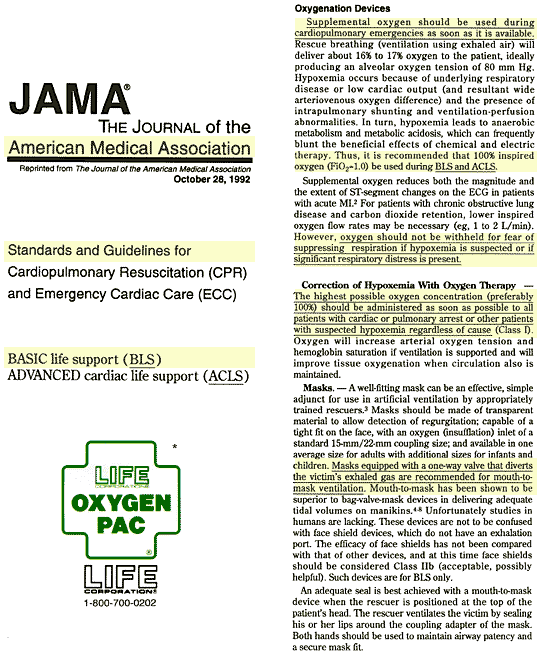
(EDIT) — We will continue to keep you advised as interpretations and the consensus develop. We are proud that our design evolutions over the past 20 years maintain our superiority in providing products that have met the AHA Guidelines of 1986, 1992, 2000, and 2005. LIFE Corporation
